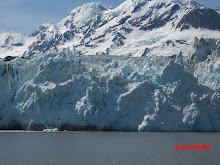

 We were invited to join Cindy C and Jan S. to dip-net on the Kenai. One needs to be an Alaskan resident for at least one year and get a free permit in order to fish by this method. The first person in the family can get 25 fish and 10 more are allowed for each family member.
We were invited to join Cindy C and Jan S. to dip-net on the Kenai. One needs to be an Alaskan resident for at least one year and get a free permit in order to fish by this method. The first person in the family can get 25 fish and 10 more are allowed for each family member.We left early in the am for the 150 mile drive to the mouth of the Kenai and met them at the RV park across from the beach. It was a beautiful, warm, sunny day. We began by loading all the gear into Jan's SUV, the coolers, a wagon and two large and one small dipnet. The dipnets are five feet in diameter with a twenty foot pole attached. Then we drove around to the beach to unload the car and load the pull wagon. It was heavy empty.
We pushed it out on the beach and unloaded. The beach was not too crowded at 9:30 am, but as fishermen and women began to arrive near the high water tide time an hour later, it became incredibly crowded. On each side of the shore for about a mile long, people were staggered about three feet apart.
The process begins as one "drives" the pole into the water. The net is perpendicular to the sand. It was heavy and hard to control with the current. When a large boat came along, it was even more challenging. Then we waited for a tug on the net indicating a Red Salmon. When that happens the net is flipped to the side and the fisherman turns around and runs to the shore. We were wearing chest waders and it was hard to run through the water with the weight of the net and fish. Our team had three nets for four people, so we took turns being the bonker. That means to hit the fish on the head between the eyes to kill it and then to rip the gills and let it bleed out in the water. It sounds pretty barbaric, but actually is more humane than letting the fish suffocate to death. Next the fish is put in the cooler and the whole process begins again.
The whole beach looked to me like an ant scene with everyone in perpetual motion doing their own thing again and again. In the end, Don caught 10 and I caught 6. Our team divided the fish equally by thirds for three families. We could have caught more fish, but our two coolers were full and we were all exhausted and the work had just begun.
We began the process of reloading the wagon only this time it was full of nets and heavy coolers full of fish. Fortunately, some young strong men helped us get it up the bridge as we left the beach. We had a break and lunch at the RV and then found another spot to clean the fish.
We had an assembly line. I washed the fish with a hose, Jan filleted them, Cindy cut the filets in half and Don packaged them and put them in ice coolers. We were all tired when we headed for home about 7:30 pm.
After about an hour on the road, we stopped in a traffic jam and the trooper explained there were two fatal accidents and the highway would be closed south of Cooper's Landing until 2 am. UGH. We tried to stop at lodges along the way and check for opening with no luck. We called the Princess Lodge and were put on a waitlist. Luckily after dinner we got a room. I didn't even ask how much it was. ($229). We were so happy to have a room.
In the morning we took our fish someplace to be vacuum packed and hiked the Russian River Falls. We came home with 37 pounds of fish.

No comments:
Post a Comment